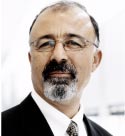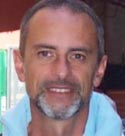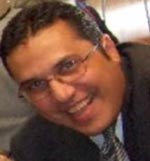
Prof. Mohamad Sawan
Canada Research Chair in Smart Medical Devices
Polystim Neurotechnologies Laboratory
Polytechnique Montreal, Canada
Mohamad Sawan was born in Lebanon. He received the Ph.D. degree in electrical engineering, from Sherbrooke University, Québec, Canada in 1990, respectively. He joined Polytechnique Montréal in 1991, where he is currently a Professor of microelectronics and biomedical engineering. His interests are the design and test of analog, digital, RF, MEMS and optic circuits and Microsystems, and clinical imaging. Dr. Sawan is a holder of a Canada Research Chair in Smart Medical Devices, he is leading the Microsystems Strategic Alliance of Quebec (ReSMiQ), and is founder of the Polystim Neurotechnologies Laboratory.
Dr. Sawan is founder and cofounder of several international conferences such as the IEEE new circuits and systems conference (NEWCAS), the IEEE Int’l conference on electronics, circuits and systems (ICECS), and the IEEE Int’l conference on biomedical circuits and systems (BIOCAS). He is also cofounder and Associate Editor (AE) of the IEEE Transactions on BIOCAS, he is Deputy Editor-in Chief of the IEEE TCAS-II, and he is Editor and AE, and member of the board of several international Journals. He published more than 600 peer reviewed papers, two books, 10 book chapters, and 10 patents.
Dr. Sawan received several awards, among them the ACFAS’s Bombardier and Jacques Rousseau Awards, and the medal of merit from the President of Lebanon, and the Barbara Turnbull Award. He is Fellow of the IEEE, Fellow of the Canadian Academy of Engineering, Fellow of the Engineering Institute of Canada, and Officer of the Quebec’s National Order.
Title: Brain-Machine Interfaces for the Recovery of Neural Vital Functions
Summary: Emerging Brain-Machine Interfaces for diagnostic and recovery of neural vital functions are promising alternative to allow studying the neural activity underlying cognitive functions and pathologies, detecting mind driven decisions, etc. This talk covers typical architectures and mixed-signal (analog, digital and RF) integrated circuits and systems techniques used for the design and integration of Microsystems intended for wireless neurorecording and treatment by neurostimulation. Global view of typical microsystems altogether with corresponding multidimensional design and implementation challenges such as power management, energy harvesting, data communication, and reliable short distance transmission will be described. Special attention will be paid to present continuous EcoG recording intended to onset detection of epileptic seizures, and for learning about the intracortical vision mechanism. In addition, microstimulation strategies in the primary visual cortex, which is intended to recover vision for the blind through multisite large arrays of microelectrodes will be reported. Also, a feedback control device, which consists of seizures onset detection and subsequent treatment through dedicated electrodes, will be described. Finally, Lab-on-chip (LoC) based neurotransmitters detection, manipulation and characterization intended for diagnostic purposes to locate dysfunctions at the level of cells interconnection will be summarized.

Prof. Corrado Schenon
Faculty of Engineering,
University of Genoa, Italia
Corrado Schenone was born in Genoa. He received the Ph.D. degree in Applied Physics, from University of Genoa, Italia, in 1987. He joined University of Genoa in 1992.
Corrado Schenone has carried out research at the "Department of Mechanical Engineering” (DIME) of the University of Genoa since November 1987. In addition to fundamental studies on heat transfer, and particularly on boiling phenomena, the main research topics concern environmental energy and noise pollution. At present, he is working about sustainable energy planning and about noise control in urban areas.
The research activity has resulted mainly in the publication of 80 scientific papers, of which 40 presented in international meetings or printed on books or journals.
Organizing activity:
- President of the Scientific Committee of the consortium “Innovative Technologies for Sustainable Development and Environmental Control” (TICASS)
- Member of the Scientific Committee of the “Interuniversity Research Centre on Physical Agents Pollution” (CIRIAF)
- Member of the Board of the” Interdepartmental Research Centre for Urban and Ecological Engineering” (CRUIE)
- Member of the Board of the “Regional Energy Agency” (ARE) of Liguria Region•
- Member of the Scientific Committee of “Genova Smart City” association
- Coordinator of the Section “Thermoenergetics and Environmental Conditioning - TEC” of the Department of Mechanical Engineering -DIME

Dr. Mohamed El-Hadidy
CST-ME General Manager
Mohamed El-Hadidy received his PhD degree in June 2009 at the Institute of Communication Technology (IKT), Leibniz University of Hannover, Germany. He leaded several research projects as a postdoc for two years and co-supervising PhD students in the fields of UWB-MIMO and Cognitive Radios communication Systems. Since July 2011, he has been with the Institute of Digital Signal Processing, University of Duisburg-Essen as the Leader of the Research Group System Simulation and Measurements (SSM). His present research topics are mainly focused on UWB-MIMO wireless communications, Channel Modeling, Interference Alignment, Cognitive Radios, Biomedical Imaging and Inverse Scattering and Test-beds Implementations. He has more than 8 years teaching experience in English/German studying programs as he worked as assistant professor in appreciated German/Egyptian Universities and Research institutes. Dr.-El-Hadidy has more than 5 years professional experience as a representative and consultant for several multi-national companies (CST, AWR, MA/COM, Satimo, MVG) in the Middle East area. He is the general manager of the CST-Middle East.
Title: Design Challenges & State of the Art of 3D EM Field Simulation
Summary: EM Simulations for the Research Activities in Communication Engineering
This talk is designed to give antenna, EMC, microwave, RF, and SI engineers an insight into the latest EM simulation technology for analysing their complex applications. It will show modern simulation technology can simulate and optimize all electromagnetic issues associated with increasingly complex 3D designs including antennas, PCBs, cables, and shielding performance of metallic enclosures.
Recent research projects and activities based on EM simulations in communication engineering as UWB MIMO VHDR communication system, biomedical imaging and Inverse Scattering (IS), Cognitive Radio (CR), Interference Alignment (IA) and localization would be presented as well.
